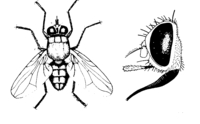Horn Flies and Cattle
ENTFACT-509: Horn Flies and Cattle | Download PDF
by Lee Townsend, Extension Entomologist
University of Kentucky College of Agriculture

Horn Fly
Horn flies are small (3/16 inch long), dark gray flies that feed on cattle and occasionally horses. Both sexes are blood feeders, taking 20 or more blood meals each day with their stiff needle-like mouthparts. Irritations from the bites annoy animals and occasionally, the wounds may become infected.
Studies have shown that horn flies have their greatest effect on growing animals. Weaning weights of calves with an average of 200 or more horn flies during the summer are about 15 pounds less than those that are protected from horn flies. The same type of impact has been seen on yearling cattle. In addition, horn flies can spread summer mastitis, which affects the mammary glands of non-lactating cows, and they have been implicated in the spread of anaplasmosis.

Fig. Horn fly treatment threshold of 100 flies per side
Horn flies stay on animals almost continuously. They characteristically rest with their heads pointing toward the ground and their wings held at a 45 to 60 degree angle to their bodies. During extremely hot weather or rains, they will move lower sides and underside of the animal. They fly up in swarms when disturbed but soon return to an animal. Females leave only to deposit their eggs on manure within about 10 minutes of it hitting the ground. This close association with cattle aids in effectiveness of control methods.
Horn fly maggots only develop in cattle manure and do best in the grass manure of pastured cattle. Few flies emerge from droppings of cattle on concentrated feed. The life cycle is completed in 10 to 14 days. Each female can lay up to 500 eggs so very large populations can build up over the summer. Winter is spent in the pupal stage beneath manure pads or in the soil, adults in late May. Without some type of fly control program, every animal in a herd may have several hundred horn flies by mid- to late summer. Bulls usually carry the heaviest infestations.
Several insecticide application options are available: insecticide impregnated ear tags, dust bags, concentrated pour-ons, animal sprays, and oral larvicides available in minerals and feed supplements. Ear tags and forced use dust bags have consistently give the best control but other methods can be effective, too. The choice can be made based on what works best with pasture layouts and herd management practices.
Insecticide resistance has become a problem, particularly associated with the use of insecticide ear tags and continued use of insecticides with the same mode of action – attacking the same site in the insect. Specific steps can be taken to manage resistance, including: 1) rotation of insecticides in ear tags with different modes of action, 2) withholding tagging until horn fly numbers reach 200 per animal, 3) only treating cattle in the growth mode, 4) use of alternative insecticides and application methods late in the season to reduce the percentage of overwintering flies with resistance; and 5) removing insecticide ear tag as soon as horn fly numbers begin to decline in the fall.
Several species of predator beetles feed on horn fly eggs and maggots in cattle droppings and may reduce horn fly production by more than 90%. Wasps sold for fly control around stables and feedlots are impractical for pasture pests, such as the horn fly. Conditions that fast drying of manure, along with activities of dung beetles also can provide some natural control.
A walk-thru fly trap has been shown to reduce horn fly numbers. Information on this approach is available in ENTFact-508.
Issued: 01/00
Revised: 01/11
CAUTION! Pesticide recommendations in this publication are registered for use in Kentucky, USA ONLY! The use of some products may not be legal in your state or country. Please check with your local county agent or regulatory official before using any pesticide mentioned in this publication.
Of course, ALWAYS READ AND FOLLOW LABEL DIRECTIONS FOR SAFE USE OF ANY PESTICIDE!
Images: University of Kentucky Entomology
